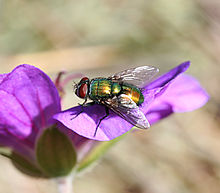Lucilia sericata
| Resource Type | Organism |
|---|---|
| Genus | Lucilia |
| Species | sericata |
| Common Name | Common green bottle fly |
| Description | The common green bottle fly (Lucilia sericata) is a blowfly found in most areas of the world and is the most well-known of the numerous green bottle fly species. Its body is 10–14 mm (0.39–0.55 in) in length – slightly larger than a house fly – and has brilliant, metallic, blue-green or golden coloration with black markings. It has short, sparse, black bristles (setae) and three cross-grooves on the thorax. The wings are clear with light brown veins, and the legs and antennae are black. The larvae of the fly may be used for maggot therapy, are commonly used in forensic entomology, and can be the cause of myiasis in livestock and pets. The common green bottle fly emerges in the spring for mating. Source: https://en.wikipedia.org/wiki/Common_green_bottle_fly |
| Publication | Davis RJ, Belikoff EJ, Dickey AN, Scholl EH, Benoit JB, Scott MJ. Genome and transcriptome sequencing of the green bottle fly, Lucilia sericata, reveals underlying factors of sheep flystrike and maggot debridement therapy.. Genomics. 2021 Oct 05; 113(6):3978-3988. |
| Organism Image |  |
| Image Credit | Common bottle fly, Lucilia sericata by Calibas, licensed under a public domain License |
 An official website of the United States government.
An official website of the United States government.
